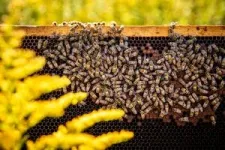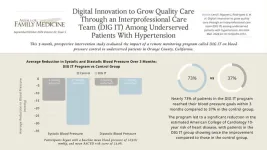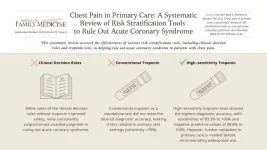(Press-News.org) CHAMPAIGN, Ill. — In a new study, researchers at the University of Illinois Urbana-Champaign tackled a thorny problem: How do nutritional stress, viral infections and exposure to pesticides together influence honey bee survival? By looking at all three stressors together, the scientists found that good nutrition enhances honey bee resilience against the other threats.
Their findings are detailed in the journal Science of the Total Environment.
“Multiple stressors are often bad for survival,” said graduate student Edward Hsieh, who led the research with U. of I. entomology professor Adam Dolezal. “However, it is always context-dependent, and you have to be aware of all these factors when you’re trying to make broad statements about how interactive effects affect honey bees.”
Most studies focus on only one or two factors at a time, Hsieh said. They will explore the interplay of poor nutrition and pesticide exposures, for example, or pesticides and viral infections. But no previous studies have looked at how all three factors contribute to honey bee declines — probably because doing so is quite challenging.
Even understanding how bees respond to all the agricultural chemicals they encounter is a complicated task, Dolezal said.
“Some insecticides will work better against some insects than others, but they tend to be more lethal than fungicides or herbicides,” he said. “Some fungicides, however, are known to make insecticides more toxic to insects.”
For the new study, the team looked at pollen collected by honey bees visiting small patches of restored prairie bordering agricultural fields in Iowa. The researchers used the maximum insecticide and fungicide levels detected in bee-collected pollen grains as their guide to likely chemical exposures in the wild.
In a series of experiments, Hsieh exposed groups of caged honey bees to different dietary, viral and/or chemical treatments. The bees were fed either artificial or natural pollen. The agricultural pesticides included chlorpyrifos, an organophosphate; lambda-cyhalothrin, a pyrethroid; or thiamethoxam, a neonicotinoid. Hsieh also infected some of the caged bees with the Israeli Acute Paralysis Virus, one of several viruses known to contribute to the collapse of honey bee colonies around the world.
The experiments yielded some obvious and some unexpected results, Dolezal said.
“What we found was that with the artificial pollen, if bees are exposed to the virus, a lot of them die. And if you expose them to the virus and pesticide at the same time, even more of them die,” he said. “However, if you do the exact same experiment but you give them better nutrition, you get a very different outcome.”
On the natural pollen diet, bees exposed to the virus still experienced higher mortality, the researchers found. But fewer bees died when they were also exposed to a mixture of chlorpyrifos and a fungicide.
“Bees have this inherent ability to deal with stress, and so if you give them a little bit of stress, like a low-level exposure to a pesticide, it may help them deal with a bigger stress from a pathogen like the virus,” Dolezal said. “However, it only works if they have the nutritional resources to do it.”
The researchers warned this doesn’t mean that chemical exposures don’t matter.
“Different pesticides have different molecular targets and do different things,” Dolezal said. “It’s not okay if bees get exposed to a little bit of any pesticide. It depends on the chemical.”
The findings offer some reassurance that providing high-quality prairie habitat near agricultural sites does not create an “ecological trap,” attracting bees to the flowers only to kill them with agricultural chemicals.
“The takeaway from this study is that bees are quite resilient even to the interaction of pesticides and viruses if they have really good nutrition,” Dolezal said. “However, we don’t want people to conclude that pesticides are not a big deal for the bees.”
Pesticides, alone or in combination with viruses, are in most cases detrimental to bees.
“But it is gratifying to know that providing high-quality habitat can at least increase their resilience to these stressors,” Hsieh said.
The Foundation for Food and Agriculture Research and the North American Pollinator Protection Campaign supported this research. Dolezal also is an affiliate of the Carl R. Woese Institute for Genomic Biology at the U. of I.
Editor’s note:
To reach Adam Dolezal, email adolezal@illinois.edu.
To reach Edward Hsieh, email emhsieh2@illinois.edu.
The paper “Nutrition, pesticide exposure and virus infection interact to produce context-dependent effects in honey bees (Apis mellifera)” is available online.
DOI: 10.1016/j.scitotenv.2024.175125
END
A multi-institutional research team led by Georgia Tech’s Hailong Chen has developed a new, low-cost cathode that could radically improve lithium-ion batteries (LIBs) — potentially transforming the electric vehicle (EV) market and large-scale energy storage systems.
“For a long time, people have been looking for a lower-cost, more sustainable alternative to existing cathode materials. I think we’ve got one,” said Chen, an associate professor with appointments in the ...
Giving women at risk of premature birth a simple magnesium sulphate infusion (or ‘drip’) can prevent their babies from developing cerebral palsy, a recent Cochrane review has confirmed. The drug itself costs approximately £5 (~$6.50) per dose in England, and requires hospital admission with experienced staff to administer the drug safely to the mother. A new editorial calls for this intervention to be implemented more widely and equitably, as it is still not consistently available worldwide.
The first Cochrane review showing that magnesium sulphate protects premature babies against cerebral palsy was published in 2009, and the recent update includes newer trials which further ...
Josh Leonardis received funding from the Eunice Kennedy Shriver National Institute of Child Health and Human Development of the National Institutes of Health to study why female manual wheelchair users experience shoulder pain and pathology at greater rates than males.
Leonardis is a researcher at the Beckman Institute for Advanced Science and Technology, an assistant professor of health and kinesiology at the University of Illinois Urbana-Champaign and the director of the Musculoskeletal Morphology and Biomechanics Laboratory.
“It’s well-documented in literature that ...
UChicago Medicine has become the first medical center in Illinois to implant the Revi neuromodulation device, an exciting new treatment option that could offer relief for patients with urinary urgency incontinence (UUI).
“I am really happy that we can offer this innovative approach to all our patients and very proud to be at the real forefront of medicine as the first in the state to have done this surgery,” said urologist Ervin Kocjancic, MD, the surgeon who performed the procedure.
UUI, a chronic, debilitating, ...
Multi-disciplinary archaeological survey at the site of Oued Beht, Morocco, reveals a previously unknown 3400–2900 BC farming society.
This is the earliest and largest agricultural complex yet found in Africa beyond the Nile.
It shares similar features with contemporaneous sites in Iberia.
This suggests the Maghreb was instrumental to the shaping of the western Mediterranean during the fourth and third millennia BC.
Archaeological fieldwork in Morocco has discovered the earliest, previously unknown farming society from a poorly understood period of north-west African prehistory.
This study, published today in Antiquity, reveals for the first ...
Background and Goal: Pre-exposure prophylaxis (PrEP) is a preventive medicine that reduces the risk of contracting HIV. There is concern that PrEP use may be associated with an increase in bacterial sexually transmitted infections (STIs) like gonorrhea, chlamydia, and syphilis among men who are gay or bisexual. This study explored the relationship between PrEP use and the rates of bacterial STIs over time.
Study Approach: Researchers used data from the iCruise Study, an online longitudinal study of men who are gay or bisexual or have sex with men, in Ontario from July 2017 to April 2018. The study examined how PrEP use related to the number of self-reported ...
Background and Goal: Obesity is a significant health issue, particularly among veterans and racial/ethnic minority groups. Primary care is a key setting for addressing obesity. However, many barriers, including time constraints and limited patient engagement, make effective treatment challenging. This study evaluated whether a technology-assisted health coaching intervention called Goals for Eating and Moving (GEM) could help high-risk patients lose weight more effectively than enhanced usual care (EUC).
Study Approach: Researchers conducted a two-arm, cluster-randomized controlled trial involving 19 primary care teams ...
Background and Goal: Underserved communities are at higher risk for uncontrolled high blood pressure (hypertension), which can lead to heart disease and higher death rates. This study evaluated the impact of a remote monitoring program called DIG IT on blood pressure control in underserved patients at a Federally Qualified Health Center (FQHC) in Orange County, California.
Study Approach: Researchers compared two groups: 70 patients using the DIG IT program, which includes digital blood pressure monitoring, medication management, and a team-based care approach, and a historical control group of 70 patients who received standard care without digital tools. The ...
Background and Goal: The HOMER study was launched to determine the most effective setting for starting buprenorphine treatment for opioid use disorder. The study faced challenges including shifts in health care delivery, changes in patient preferences, and the emergence of telehealth. The goal was to adapt the study to these circumstances while maintaining its focus on patient-centered care and effective treatment outcomes.
Key Insights: The HOMER study had to quickly adapt to challenges brought on by the COVID-19 pandemic. With community input, the study design evolved to include a third arm, ...
Background and Goal: Chest pain is a common but challenging symptom for general practitioners to evaluate, as it can be caused by both serious conditions and more benign issues. This study assessed the effectiveness of various risk stratification tools, including clinical decision rules and troponin tests, in helping general practitioners rule out acute coronary syndrome in patients with chest pain.
Study Approach: Researchers conducted a systematic review of studies involving adult patients presenting ...








